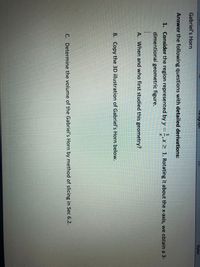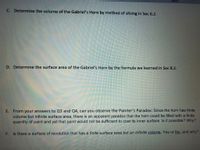
Calculus: Early Transcendentals
8th Edition
ISBN: 9781285741550
Author: James Stewart
Publisher: Cengage Learning
expand_more
expand_more
format_list_bulleted
Question

Transcribed Image Text:Palaglaph
Styles
Gabriel's Horn
Answer the following questions with detailed derivations:
1. Consider the region represented by y = ,x > 1. Rotating it about the x-axis, we obtain a 3-
dimentional geometric figure.
A. When and who first studied this geometry?
B. Copy the 3D illustration of Gabriel's Horn below.
C. Determine the volume of the Gabriel's Horn by method of slicing in Sec 6.2.

Transcribed Image Text:Styles
C. Determine the volume of the Gabriel's Horn by method of slicing in Sec 6.2.
D. Determine the surface area of the Gabriel's Horn by the formula we learned in Sec 8.2.
E. From your answers to Q3 and Q4, can you observe the Painter's Paradox: Since the horn has finite
volume but infinite surface area, there is an apparent paradox that the horn could be filled with a finite
quantity of paint and yet that paint would not be sufficient to coat its inner surface. Is it possible? Why?
F. Is there a surface of revolution that has a finite surface area but an infinite volume. Yes or No, and why?
Expert Solution
This question has been solved!
Explore an expertly crafted, step-by-step solution for a thorough understanding of key concepts.
Step by stepSolved in 4 steps with 1 images

Knowledge Booster
Similar questions
- 4. Pretend the three squares you see below are each one square yard. So what you are looking at in total is what we mean when we say the phrase "three square yards." a. How big are these three square yards in square feet? Use dimensional analysis and the facts in the green box above.arrow_forward... Parks will be built adjacent to two circular retention ponds. Each pond has 5 miles in radius. Each park will be covered with grass in the area depicted in light green in the figure below. What is the area of one of the parks? If all sides of each park need to be fenced (e.g. one straight side and the two circular sides bordering each park), what is the length of the fence needed? Describe how you came to your answers. 5. The area of the park: The length of the fence: Edit View Insert Format Tools Table 12pt v Paragraph v MacBook Air 000 000 DD F3 F4 F5 F8 %23arrow_forwardProblem B. - A Norman Window is a sectangle with a semicicle on top. [Ser diogrom The perimeter of te window is 24 fH. Maxinize te Area of this windw and tigure out it's dinensions. +SCarrow_forward
- 3. A circle of radius 987.03ft centered at point A, intersects another circle of radius 1179.54 ft centered at point B. The X and Y coordinates (in feet) of A are 1958.74 and 4211.23, respectively and those of point B are 2561.52 and 2324.21, respectively. What are the coordinates of the intersection point(s)? If the radius of the circle at point A was changed to 753.34ft, what would be the intersection point? Comment on your results.arrow_forward1. Amy wants to her ice cream cone filled exactly to the top. The radius of the cone is 2 in. and the height is 6 in. How much ice cream will it take to fill the cone? 8 Note: As you can see, an ice cream cone is an upside down cone. This doesn't change the formula.....arrow_forward
arrow_back_ios
arrow_forward_ios
Recommended textbooks for you
 Calculus: Early TranscendentalsCalculusISBN:9781285741550Author:James StewartPublisher:Cengage Learning
Calculus: Early TranscendentalsCalculusISBN:9781285741550Author:James StewartPublisher:Cengage Learning Thomas' Calculus (14th Edition)CalculusISBN:9780134438986Author:Joel R. Hass, Christopher E. Heil, Maurice D. WeirPublisher:PEARSON
Thomas' Calculus (14th Edition)CalculusISBN:9780134438986Author:Joel R. Hass, Christopher E. Heil, Maurice D. WeirPublisher:PEARSON Calculus: Early Transcendentals (3rd Edition)CalculusISBN:9780134763644Author:William L. Briggs, Lyle Cochran, Bernard Gillett, Eric SchulzPublisher:PEARSON
Calculus: Early Transcendentals (3rd Edition)CalculusISBN:9780134763644Author:William L. Briggs, Lyle Cochran, Bernard Gillett, Eric SchulzPublisher:PEARSON Calculus: Early TranscendentalsCalculusISBN:9781319050740Author:Jon Rogawski, Colin Adams, Robert FranzosaPublisher:W. H. Freeman
Calculus: Early TranscendentalsCalculusISBN:9781319050740Author:Jon Rogawski, Colin Adams, Robert FranzosaPublisher:W. H. Freeman
 Calculus: Early Transcendental FunctionsCalculusISBN:9781337552516Author:Ron Larson, Bruce H. EdwardsPublisher:Cengage Learning
Calculus: Early Transcendental FunctionsCalculusISBN:9781337552516Author:Ron Larson, Bruce H. EdwardsPublisher:Cengage Learning

Calculus: Early Transcendentals
Calculus
ISBN:9781285741550
Author:James Stewart
Publisher:Cengage Learning

Thomas' Calculus (14th Edition)
Calculus
ISBN:9780134438986
Author:Joel R. Hass, Christopher E. Heil, Maurice D. Weir
Publisher:PEARSON

Calculus: Early Transcendentals (3rd Edition)
Calculus
ISBN:9780134763644
Author:William L. Briggs, Lyle Cochran, Bernard Gillett, Eric Schulz
Publisher:PEARSON

Calculus: Early Transcendentals
Calculus
ISBN:9781319050740
Author:Jon Rogawski, Colin Adams, Robert Franzosa
Publisher:W. H. Freeman


Calculus: Early Transcendental Functions
Calculus
ISBN:9781337552516
Author:Ron Larson, Bruce H. Edwards
Publisher:Cengage Learning